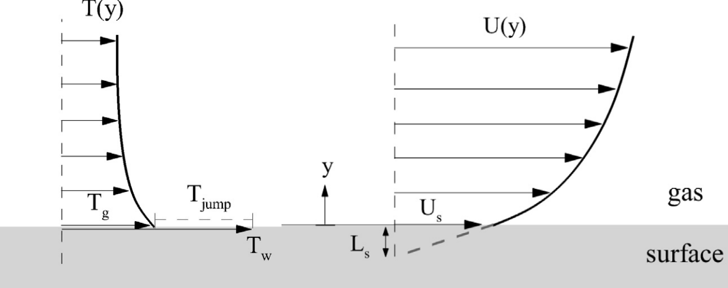When the control volume is used with \( \mathbf{b} = \mathbf{u}_s \) and the integral form of the energy conservation equation accounting for internal and kinetic energy, work done by body and surface forces, and heat flux across a boundary\(\boxed{\small \frac{d}{dt} \int_{V^*(t)} \rho \left( e + \frac{1}{2} |\mathbf{u}|^2 \right) dV + \int_{A^*(t)} \left( \rho e + \frac{\rho}{2} |\mathbf{u}|^2 \right) (\mathbf{u} - \mathbf{b}) \cdot \mathbf{n} \, dA = \int_{V^*(t)} \rho \mathbf{g} \cdot \mathbf{u} \, dV + \int_{A^*(t)} \mathbf{f} \cdot \mathbf{u} \, dA - \int_{A^*(t)} \mathbf{q} \cdot \mathbf{n} \, dA} \)
However, it is known to be violated in rarefied gases and is related to viscous slip in such flows

Velocity slip (\( U_s \)), slip length (\( L_s = \frac{U_s}{dU/dy} \)), and temperature jump (\( T_{\text{jump}} \)) in the presence of non-equilibrium gas–surface interactions in rarefied gas flows
1 Hassan Akhlaghi, Ehsan Roohi and Stefan Stefanov. A Comprehensive Review on Micro- and Nano-Scale Gas Flow Effects: Slip-Jump Phenomena, Knudsen Paradox, Thermally-Driven Flows, and Knudsen Pumps. Physics Reports, vol. 997, 1 Jan. 2023, pp. 1–60.